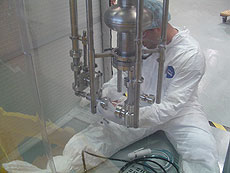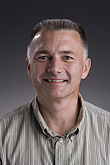|
Have a safe day!
Wednesday, March 31
3:30 p.m.
DIRECTOR'S COFFEE BREAK - 2nd Flr X-Over
4 p.m.
Fermilab Colloquium - One West
Speaker: Margaret Murnane, University of Colorado, Boulder / NIST
Title: Attosecond Light and Science at the Time-scale of the
Electron - Coherent X-Rays from Tabletop Ultrafast Lasers
Thursday, April 1
10:30 a.m.
Particle Astrophysics Seminar - One West (NOTE DATE and TIME)
Speaker: Andrea Lommen, Franklin and Marshall College
Title: The North American Nanohertz Observatory of Gravitational Waves (NANOGrav)
2:30 p.m.
Theoretical Physics Seminar - Curia II
Speaker: Julius Kuti, University of California, San Diego
Title: Lattice Studies of the Nearly Conformal Composite Higgs Mechanism
3:30 p.m.
DIRECTOR'S COFFEE BREAK - 2nd Flr X-Over
4 p.m.
Accelerator Physics and Technology Seminar - One West
Speaker: Mohammed Awida, University of Tennessee, Knoxville
Title: Twisted Waveguide Accelerating Structures: Potential and Challenges
Click here for NALCAL,
a weekly calendar with links to additional information.
Upcoming conferences |
|
For information about H1N1, visit Fermilab's flu information site.
|
|
Wednesday, March 31
- English muffin sandwich
- Beef barley soup
- Gyros
- Caribbean grille salmon
- Stuffed pepper
- Beef and cheddar panini
- Assorted sliced pizza
- Grilled chicken bowtie pasta w/tomato cream
Wilson Hall Cafe Menu |
|
Wednesday, March 31
Lunch
- Chicken w/lime sauce
- Cumin roasted potatoes
- Sautéed zucchini
- Chocolate raspberry cake
Thursday, April 1
Dinner
- Brochettes of melon, prosciutto & fresh mozzarella
- Lobster tail w/champagne butter sauce
- Saffron rice & red pepper pilaf
- Honey-glazed peach tart w/mascarpone cream
Chez Leon Menu
Call x3524 to make your reservation.
|
|
|
India-Fermilab SRF cavity passes first test

Morgan Carter, of Fermilab's Technical Division, prepares a single-cell cavity fabricated in India for testing in Fermilab's Vertical Test Stand. Photo courtesy of Avinash Puntambekar, RRCAT.
The successful test of an Indian-made superconducting radio-frequency cavity moves Fermilab one step closer to building a next-generation accelerator, the proposed Project X. It also moves India closer to meeting its nuclear energy needs.
"It is basically a win-win for both Fermilab and India," said Avinash Puntambekar, a mechanical engineer from India working with Fermilab on SRF technology. "We share the work; we share the success."
The group celebrated last month when one of the first two single-cell, 1.3 GHz cavities fabricated in India successfully tested at a gradient of 21 megavolts per meter (MV/m), higher than the 19 MV/m required for Project X cavities, but below the 35 MV/m needed for next-generation linear collider cavities. The fabrication work was carried out at Raja Ramana Center for Advanced Technology, or RRCAT, and Inter University Accelerator Center, or IUAC. The processing of this cavity was carried out jointly by RRCAT, Fermilab and Argonne National Accelerator Laboratory.
"For their very first cavity to reach this high of a gradient is very good. Historically the first cavities rarely go above 20 MV/m," said Genfa Wu of Fermilab's Technical Division SRF research and development group.
SRF cavities enable accelerators to increase particle beam energy levels while minimizing the use of electrical power by all but eliminating electrical resistance. The technology is so complex that only a few vendors outside of national laboratories can meet stringent research design standards.
Read more
|
Large Hadron Collider smashes protons, sets record
From National Geographic, March 30, 2010
The Large Hadron Collider (LHC) reached a much-anticipated milestone today when it began smashing subatomic particles together at half its maximum power.
Earlier this month the "big bang machine" had broken its own energy record when it sent two 3.5-trillion-electron-volt (TeV) proton beams racing in opposite directions around the collider's 17-mile-long (27-kilometer-long) underground tunnel.
Today, at 1:06 p.m. local time in Geneva, Switzerland, LHC operators smashed those beams of protons together to create a record-shattering 7-TeV collision.
Reaching this point has been "marvelous," said David Evans, a physicist at the University of Birmingham in the U.K. and head of the LHC's ALICE detector project.
Read more
|
Ask a nuclear physicist: What exactly did the L.H.C. do today?
From Vanity Fair, March 30, 2010
Today brought the exciting news that Switzerland's Large Hadron Collider "mashed beams of protons together at energies that are 3.5 times higher than previously achieved." This was joyous news, for some reason! According to the B.B.C., many scientists are describing the event as the onset of "a new era in science" that will allow researchers to understand "why matter has mass." But what exactly does smashing protons together even prove, and why does it matter? Was that pun intended? And were we really in danger of enveloping the entire planet in a black hole?
To find out, we spoke with VF.com's go-to scientist, Professor John Parsons of Columbia University, who actually has a hand in L.H.C. goings-on, for another edition of Ask a Nuclear Physicist.
VF Daily: What's the significance of all of this, in layman's terms?
Professor Parsons: This is the beginning of the operations phase of the L.H.C., which has started producing proton-proton collisions at a new world record energy, 7 TeV (~3.5X higher than at Fermilab near Chicago, the accelerator which has been the highest until recently). The experiments, which we have been building for close to 20 years, are now starting to record and analyze these collisions, which recreate on a microscopic scale the conditions less than one-billionth of a second after the Big Bang. If there are new types of particles which exist (such as those proposed in supersymmetry),we should be able to create them in the lab and study their properties, hopefully answering some of the mysteries about how the universe began and how it got to be the way we see it today. For example, we know ~25 percent of the universe is some exotic form of matter that we call "dark matter," but we don't know what it is made of. Supersymmetric particles are a leading candidate, but there are also other ideas around.
Read more
|
|
|
New environmental efforts
Randy Ortgiesen, head of the Facilities Engineering Services Section, wrote this week's column.
 |
| Randy Ortgiesen |
Reducing energy consumption, saving water and managing greenhouse gases are governmental efforts that have been around for many years.
Most recently the Department of Energy has taken up two new initiatives that focus on energy reduction - and onenvironmental leadership and sustainability.
These initiatives encompass:
- Significantly reducing energy usage
- Reducing green house gases
- Reducing fossil fuel use in fleet vehicles
- Employing water conservation strategies, including responsible storm water management
- Recycling general waste and construction and demolition waste
- Ensuring that new contracts specify materials with recycled and bio-based content and are environmentally preferable
- Demonstrating that existing buildings meet the guiding principles of sustainability, new buildings meet leadership in environmental and energy design (LEED) criteria, and that all new buildings are zero-net energy starting in 2020
The highest levels of DOE thankfully recognize that new investments are necessary to achieve these very aggressive mandates. Plans for implementation of these initiatives are currently under development.
However, Secretary of Energy Steven Chu believes that a majority of these reductions can come from behavioral changes, rather than expensive engineered solutions.
While federal mandates, contract performance goals and new funding for the initiatives contribute to improving our environment and level of sustainability, real progress can come from caring enough to change our behavior. A concerned employee recently inquired about what the proper building thermostat settings were in summer and winter, since the heating, ventilating and air conditioning systems in that particular building varied widely. This is a good example of an individual caring enough to ask a question that alerts building management to a possible improvement.
Employees who notice and call in a work order or simply turn off unused, non-essential lights are an important part of the behavior equation referred to by Chu. Fermilab has done well during the past decade and continues to make progress in automation and monitoring of HVAC systems to optimize climate control and conserve energy, but we can do more.
Individual motivation to do the right thing can make a difference at home or at work. Oh, and the answer to the question mentioned earlier is that winter heat settings should remain at 68 degrees Farenheit, with summer cooling settings at 78 degrees Farenheit for occupied building spaces.
|
ES&H weekly report, March 30
This week's safety report, compiled by the Fermilab ES&H section, includes no injuries. Find the full report here.
Safety report archive
|
|